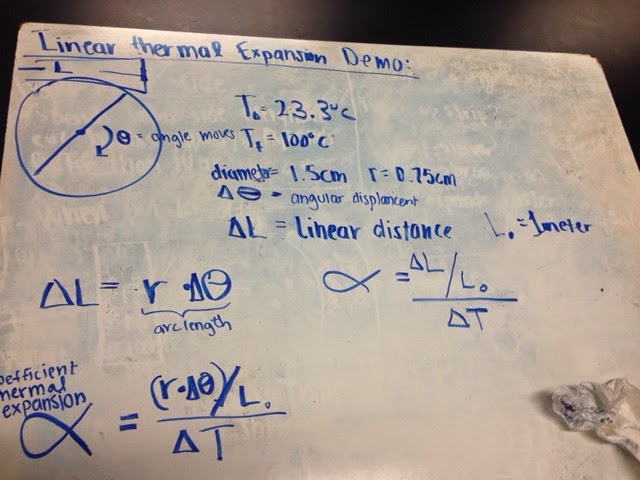Then we solved a problem about thermal expansion: when we heat up the metal bar, what variables the final length will depend on? 1. initial length. 2. material 3. temperature Tf-Ti. The property of the material is represented as alpha. alpha=(deltaL/Li)/deltaT. This is called the coefficient of thermal expansion. likewise, we have another coefficient of thermal expansion of volume called Beta. which =(deltaV/Vi)/deltaT
Bimetallic strip is made of a strip of brass and invar. No matter we heat up invar side or brass side, the strip will bend to the invar side. on the contrary, if we put strip into ice, the strip always bends to the brass side.
I this value valid or not?
We need to propagate the uncertainty of the measured variables.
thus, we have the result:
Therefore, I would report the alpha as
Then, we heat up a mixture of water and ice for 5 minutes until boiling. And continue to boil for another 5 minutes. We assume the graph should look like this:
The logger pro show the actual graph, which is not what we have predicted.
A question is raised; why did it stay constant? why does it have a small slope at the beginning?
The graph shows us: speeding up the molecules and breaking bond.
Given the slope and power, we can calculate the mass of the mixture by deducting the formula Q=mc deltaT. We get m=177.7g
By given the conditions: delta m=80g. delta t=60s power=292w
We can calculate the latent heat of the system.
Graph shows the breaking bonds in ice is easier than in steam.
We conclude that heat flows from hot to cold.
We solve a problem: add 215kJ energy to 790g ice @ -5 degree, and find the final temperature.
The energy does not completely melt the ice.
We solve another problem: There is 255g ice at -12 degree. How much water at 22 degree we need to add to vessel to make the ice get to 0 degree?
Then, we are introduced to the ideal gas law.
We did our first experiment, which is calculating the pressure by measuring the displacement of the water movement in the tube..
Here is the video taken while doing the experiment:
From P=F/A, we have concluded P=hpg in this case. (The deduction process is as shown below on the left side of the white board)
Then, we plug in the measured values and compute the pressure=539 pascals.



























